
Tips for 365 days of homegrown onions
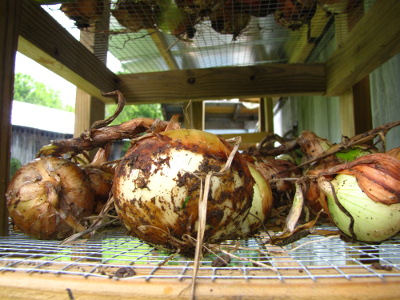 "Hi Anna- another curious inquiry: I know you've mentioned what type of
onions you grow on your homestead, but would you please repeat it again,
and how much did you plant this year to finally have enough to last you
through the winter? Our homestead will be the same size of yours and it
would be helpful to have an idea of the ideal amount to plant without
having to go through eight years of trial and error!"
"Hi Anna- another curious inquiry: I know you've mentioned what type of
onions you grow on your homestead, but would you please repeat it again,
and how much did you plant this year to finally have enough to last you
through the winter? Our homestead will be the same size of yours and it
would be helpful to have an idea of the ideal amount to plant without
having to go through eight years of trial and error!"
This is an excellent
question, especially since it's taken us several years to figure out
each aspect of growing our own onions. The first place to start is
with deciding if you want to 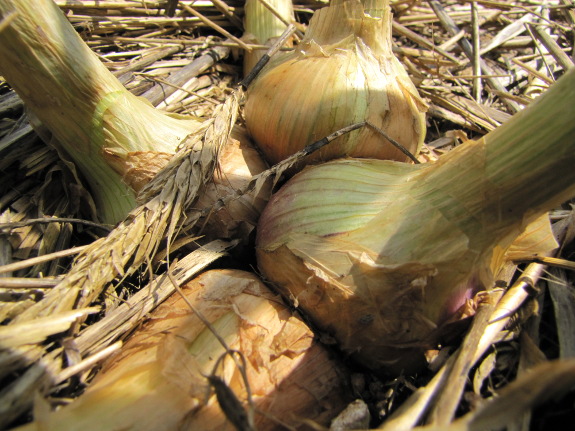 grow
from sets or from seed. Although I don't have first-hand data to
back this up, the books all say that onions from sets won't be good
keepers, so we chose to grow from seed. However, some farmers are
smart and grow both --- using the onions from sets (easy to grow, but
more expensive to start) for eating over the summer, then keeping the
onions grown from seed for winter eating. Part of our success with
still having onions at the end of December is actually do to a variant
of this method --- I used a bunch of our potato onions in summer soups, which left many more of our onions from seed to store for the winter.
grow
from sets or from seed. Although I don't have first-hand data to
back this up, the books all say that onions from sets won't be good
keepers, so we chose to grow from seed. However, some farmers are
smart and grow both --- using the onions from sets (easy to grow, but
more expensive to start) for eating over the summer, then keeping the
onions grown from seed for winter eating. Part of our success with
still having onions at the end of December is actually do to a variant
of this method --- I used a bunch of our potato onions in summer soups, which left many more of our onions from seed to store for the winter.
Which moves me on to one
of the questions you actually asked --- what variety did we settle on
for the onions we grew from seed? We grew Pontiac this year with
great success, but before you go out and buy your seeds, please read this post about the difference between short-day and long-day onions.
The short version is that southerners and northerners need to choose
different varieties of onions --- we live in the middle, but long-day
onions did better for us in my trial.
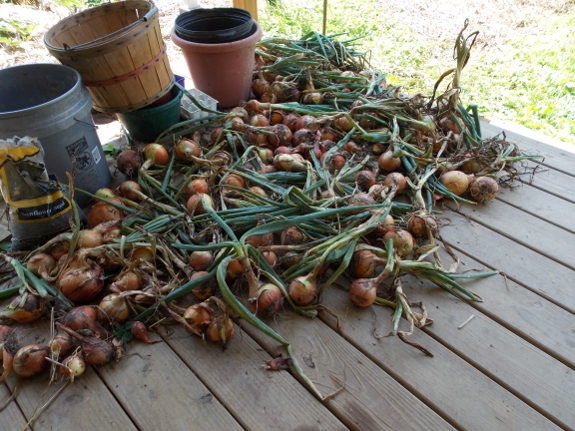
How much did we
grow? We planted seven beds of onions this spring, which equates
to about 126 square feet of onions. As I'll explain shortly, we're
still working the kinks out of starting our seedling onions, so I
probably could have gotten about 50% more onions out of that area if I'd
made sure all of the seedlings survived transplant and spring cold
snaps. And I'm afraid I didn't weigh our onion harvest this year
since I started cutting into them before they were done curing.
Suffice it to say that we're big onion eaters, needing an onion in most
things I cook, then take a look at the photo above to get an idea of the
harvest quantity.
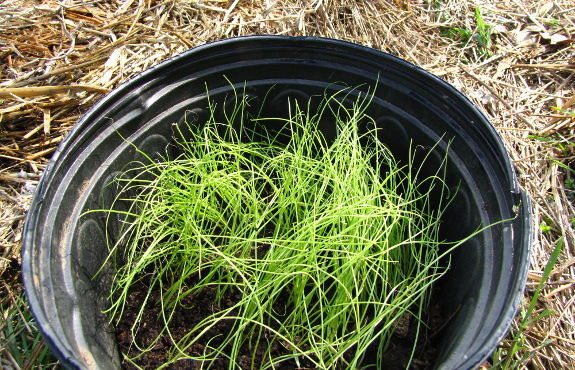 The
final factor I want to point out is the importance of getting your
onion seedlings off to a good start. After various sorts of trial
and error, I've settled on starting the seedlings in pots (one big pot
works well) inside around the beginning to middle of February.
Onion seedlings are very slow growers, so you won't need to do lots of
potting up --- just keep them somewhere they won't freeze solid during
spring cold snaps. I set out the seedlings in early April
directly into the soil (although you can set them out sooner under
quick hoops), then harvested plump bulbs in the middle of August.
The
final factor I want to point out is the importance of getting your
onion seedlings off to a good start. After various sorts of trial
and error, I've settled on starting the seedlings in pots (one big pot
works well) inside around the beginning to middle of February.
Onion seedlings are very slow growers, so you won't need to do lots of
potting up --- just keep them somewhere they won't freeze solid during
spring cold snaps. I set out the seedlings in early April
directly into the soil (although you can set them out sooner under
quick hoops), then harvested plump bulbs in the middle of August.
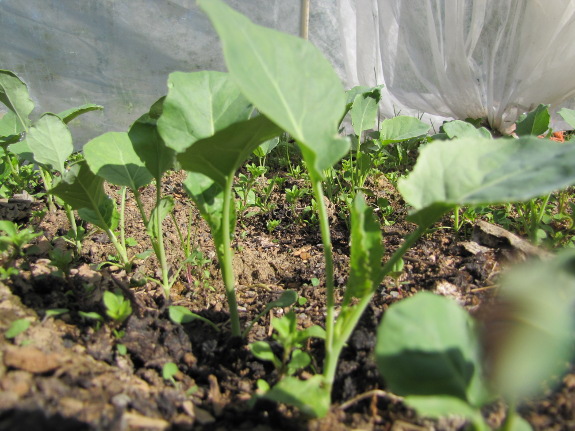 I
had actually planned to plant twice as many onion beds in 2013, but
didn't have enough seedlings for various reasons. I'm used to
pushing the envelope with old seeds, but learned the hard way that onion
seeds are one of the few that germinate very poorly when more than a
year old. Meanwhile, I also discovered that they're very prone to
damping off in homemade potting soil. In 2014, I'll be buying all
new seed, and will try half of our seeds under quick hoops since this method of starting broccoli and cabbage transplants has been a real winner in our spring garden.
I
had actually planned to plant twice as many onion beds in 2013, but
didn't have enough seedlings for various reasons. I'm used to
pushing the envelope with old seeds, but learned the hard way that onion
seeds are one of the few that germinate very poorly when more than a
year old. Meanwhile, I also discovered that they're very prone to
damping off in homemade potting soil. In 2014, I'll be buying all
new seed, and will try half of our seeds under quick hoops since this method of starting broccoli and cabbage transplants has been a real winner in our spring garden.
In other words, I've
still got more to learn! But hopefully this post will save you at
least six or seven years of trial and error. Happy onioning!
Want more in-depth information? Browse through our books.
Or explore more posts by date or by subject.
About us: Anna Hess and Mark Hamilton spent over a decade living self-sufficiently in the mountains of Virginia before moving north to start over from scratch in the foothills of Ohio. They've experimented with permaculture, no-till gardening, trailersteading, home-based microbusinesses and much more, writing about their adventures in both blogs and books.
Want to be notified when new comments are posted on this page? Click on the RSS button after you add a comment to subscribe to the comment feed, or simply check the box beside "email replies to me" while writing your comment.

Wow! You eat a ton of onions! I have gotten us through the winter on about 15sf of onions. I figure about 4 storage onions per sf...60 onions per winter...that's about 2 per week, which is enough for us.
I always use sets, Stuttgarter for preference. For a dollar, I can get all the sets I need (and then some) and I just don't have the patience to nurture onions along from Feb onward. They seem to store fine; some always sprout but some always make it to spring.
I also plant them at double density - 3" centers - and during the summer, I remove and eat every other one at the "bulb onion" stage. What's left grows out on 6" centers to bulb up for winter. Steady water and a little shade (I.e., not too hot and dry) helps them get up to size.
Stephen --- I haven't started saving seeds of root crop biennials (carrots, onions) yet because you have to dig the tuber, save it over the winter, then replant and let it bloom. I might get there eventually, but at the moment am growing hybrids, so I'd have to choose an heirloom variety first. Saving onion seeds definitely isn't low-hanging fruit like squash, tomatoes, etc.
Emily --- Yeah, onions are one of our food groups around here. Mostly because our meals are very heavy on soup, and every soup starts with two or four onions....
Thanks Anna! This is the sort of detail I was hoping for! Happy New Years to you and Mark.
~Karen B.